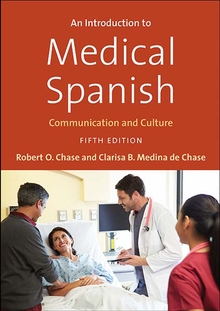Introduction to Medical Spanish - Resources
WARNING
You are viewing an older version of the Yalebooks website. Please visit out new website with more updated information and a better user experience: https://www.yalebooks.com
You are viewing previews of resources only.
To view full versions please log in or create an account to request access.
- Chapter 1
- Chapter 2
- Chapter 3
- Chapter 4
- Chapter 5
- Chapter 6
- Chapter 7
- Chapter 8
- Chapter 9
- Chapter 10
- Chapter 11
- Chapter 12
- Student Resources
- Instructor Resources
-
Notes to Students
Getting to Carnegie Hall
This is an old one. A man in New York City asked a cabbie how to get to Carnegie Hall, and the cabbie said, "Practice!" Here's an update. Speaking is not only the goal of language learning. It is the instructional method itself. Conversation is both the means and the ends. Like riding a bicycle or playing tennis, it is a learn-by-doing proposition. In a technical pub, grammar is a programming language; conversation is a user interface. Speak Spanish everywhere you can. As soon as you learn a new word, phrase, or question, practice using it with every Spanish-speaker you meet. Travel, visit ethnic shops and restaurants; speak to your neighbors, patients, and coworkers; reinforce and consolidate your learning by using it in natural contexts to make meaningful conversation.
Avoid the temptation to think in your first language and translate to Spanish, especially when preparing an oral or written project. Wherever possible, study new vocabulary by drawing and labeling pictures (flash cards), by writing sentence-length captions for your drawings, and by writing the words in meaningful sentences that you use associated words and settings. Translating in an advanced skill that requires many years of study. Speaking is something that you begin to do on page one of your textbook.
In summary, we don't learn language: we acquire it. This is why immersion is a good method. Speaking a second language requires practice. Learning happens when the learner takes responsibility for autonomous production of speech to accomplish real-life, meaningful tasks. Your textbook provides many opportunities to use Spanish in simulated medical situations with your teacher and classmates. You may feel awkward, nervous, or vulnerable at first. However, speaking Spanish in the classroom will help you achieve your goal of speaking with patients in unrehearsed settings.A Verb's Eye View
Many learners struggle at first with the morphology of verbs. In this book, we use a chart that looks like this chart of conjugations of the verb ser in the present tense:
Yo Soy Soy oftalmólogo Tú Eres ¿Eres de Guatemala? Él, ella, usted Es La doctora es simpática. Nostoros/nosotras Somos Mi esposa y yo somos peruanos. Ellos, ellas, ustedes Son Los pacientes son interesantes Although we usually provide several examples of sentences, here is an alternative explanation that may help you. People speak in the first person, second person, and third person. The speaker is the first person. Speaking in the first person is to speak of oneself. The first person singular of the verb ser is soy. It can also be plural, which is somos. Plural means that I am including others and myself as a group.
Singular first person:
Soy el doctor López. I am doctor López. Soy cubano. I am Cuban. Soy de Cuba. I am from Cuba. Soy cardiólogo. I am a cardiologist. Plural first person:
Nosotros Somos pacientes. We are patients. Tú y yo somos dominicanos. You and I are Dominicans. Somos de Nicaragua. We are from Nicaragua. The person to whom you speak is the second person. Speaking in second person is to ask about or talk about the person to whom you are addressing. In Spanish, the second person can be formal (for addressing strangers and persons of high social standing) and informal (for addressing children and friends, or persons with whom you are on a first-name basis).
Formal second person:
¿De dónde es usted? Where are you from? ¿Cómo es usted? What are you like? Informal second person:
¿De dónde eres? Where are you from? ¿Cómo eres? What are you like? The third person is someone that you are speaking about, but not the person you are addressing. Speaking in third person is to ask or tell about a third party. It can be singular and plural.
Singular third person:
¿Quién es él? Who is he? La doctora es amable. The doctor is nice. Plural third person:
Ellos son enfermeros. They are nurses. Ustedes son amables. You are all nice. Tú y Jorge son altos. You and Jorge are tall. Mis padres son ancianos. My parents are old.

